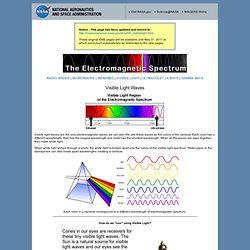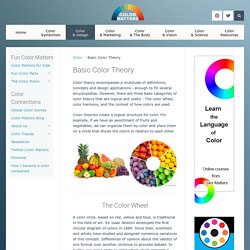

Artists that use silhouette. Color Systems - Subtractive & Additive Color. Available color systems are dependent on the medium with which a designer is working.

When painting, an artist has a variety of paints to choose from, and mixed colors are achieved through the subtractive color method. When a designer is utilizing the computer to generate digital media, colors are achieved with the additive color method. Subtractive Color. When we mix colors using paint, or through the printing process, we are using the subtractive color method. Subtractive color mixing means that one begins with white and ends with black; as one adds color, the result gets darker and tends to black. Visible Light Waves. Visible Light Waves Visible light waves are the only electromagnetic waves we can see.

We see these waves as the colors of the rainbow. Each color has a different wavelength. Light and color: an introduction. Making fine prints in your digital darkroomLight and color: an introductionby Norman Koren updated Jan. 8, 2004 This page introduces the basic concepts of light and color.

Color theory is dealt with in more depth in the series on Color management. Light and Color We begin with a review of light and color. The human eye is sensitive to electromagnetic radiation with wavelengths between about 380 and 700 nanometers. Additive color: Combine light sources, starting with darkness (black). You can obtain a wide range of colors, but not all the colors the eye can see, by combining RGB light. The Science of Light : Colored Shadows. Physics of Light and Color - Primary Additive Colors: Interactive Java Tutorial.
Interactive Java Tutorials Primary Additive Colors Light is perceived as white by humans when all three cone cell types of the eye are simultaneously stimulated by equal amounts of red, green, and blue light.

Because the addition of these three colors yields white light, the colors red, green, and blue are termed the primary additive colors. This tutorial explores how the three primary additive colors interact with each other, either in pairs or all together. The tutorial initializes with red, green, and blue filled circles randomly bouncing within the confines of the tutorial window. The human eye is sensitive to a narrow band of electromagnetic radiation that lies in the wavelength range between 400 and 700 nanometers, commonly known as the visible light spectrum, which is the only source of color. When only one or two types of cone cells are stimulated, other (non-white) colors are visualized. Contributing Authors Matthew J.
Questions or comments? Physics of Light and Color. Light and Color Light is a complex phenomenon that is classically explained with a simple model based on rays and wavefronts.

The Molecular Expressions Microscopy Primer explores many of the aspects of visible light starting with an introduction to electromagnetic radiation and continuing through to human vision and the perception of color. Each section outlined below is an independent treatise on a limited aspect of light and color.
We hope you enjoy your visit and find the answers to your questions. Electromagnetic Radiation - Visible light is a complex phenomenon that is classically explained with a simple model based on propagating rays and wavefronts, a concept first proposed in the late 1600s by Dutch physicist Christiaan Huygens. Light: Particle or a Wave? Sources of Visible Light - A wide variety of sources are responsible for emission of electromagnetic radiation, and are generally categorized according to the specific spectrum of wavelengths generated by the source.
Kenneth R. Color Tools for Webmasters, Web Designers & CSS Geeks at ColorTools.Net. Light and Color @ The Franklin Institute. Color Matters - Design and Art - Color Theory. Color theory encompasses a multitude of definitions, concepts and design applications - enough to fill several encyclopedias.

However, there are three basic categories of color theory that are logical and useful : The color wheel, color harmony, and the context of how colors are used. Color theories create a logical structure for color. For example, if we have an assortment of fruits and vegetables, we can organize them by color and place them on a circle that shows the colors in relation to each other. ARTstor. Color Scheme Designer 3. The Hyperbolic Crochet Coral Reef. Asea of vibrant colors and fantastic structures, the Hyperbolic Crochet Coral Reef Project was exhibited in the Sant Ocean Hall Focus Gallery from October 16, 2010 through April 24, 2011.

Created by Margaret and Christine Wertheim of the Institute for Figuring, the project uses crocheting techniques that employ hyperbolic geometry to create complex, natural-looking forms, drawing connections between the crocheted reefs and living corals, such as the Great Barrier Reef in Australia. The Smithsonian Community Reef A satellite of the worldwide Hyperbolic Crochet Coral Reef Project created by Margaret and Christine Wertheim of the Institute For Figuring in Los Angeles.
Looking at Music 3.0. Keith Haring. Jill Newhouse Gallery. Louisa Waber.